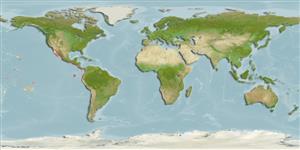Common names from other countries
>
Eupercaria/misc (Various families in series Eupercaria) >
Haemulidae (Grunts) > Haemulinae
Etymology: Haemulopsis: Greek, haimaleos = bloody + Greek, opsis = with appearance (Ref. 45335).
More on author: Günther.
Environment: milieu / climate zone / depth range / distribution range
Ecologia
marinhas; estuarina demersal. Tropical; 32°N -
Eastern Pacific: Gulf of California to Peru.
Tamanho / Peso / Idade
Maturity: Lm ? range ? - ? cm
Max length : 45.7 cm TL macho/indeterminado; (Ref. 115882); common length : 25.0 cm TL macho/indeterminado; (Ref. 9114); peso máx. Publicado: 590.00 g (Ref. 40637)
Body robust, somewhat compressed, and not very deep (depth contained 2.8 to 3.0 times in standard length); mouth small and terminal, its posterior end located at the same level as the anterior rim of the eye; profile of head convex; first gill arch with 18 to 23 gill rakers; dorsal fin deeply notched, with 12 spines and 14 to 15 soft rays (XII, 14-15); second anal spine stronger and but shorter than third; third anal spine, when bent, reaching or surpassing base of last anal ray;; back brownish gray; belly lighter; axilla of pectoral fins and upper edge of operculum black (Ref. 55763)
Inhabits coastal seas on sandy or muddy bottoms (Ref. 11482). Found in estuaries (Ref. 9114). Feeds on polychaetes, copepods and amphipods (Ref. 50313). Marketed fresh (Ref. 9114).
Life cycle and mating behavior
Maturidade | Reprodução | Desova | Ovos | Fecundidade | Larvas
Oviparous, distinct pairing during breeding (Ref. 205).
McKay, R.J. and M. Schneider, 1995. Haemulidae. Burros, corocoros, chulas, gallinazos, roncos. p. 1136-1173. In W. Fischer, F. Krupp, W. Schneider, C. Sommer, K.E. Carpenter and V. Niem (eds.) Guia FAO para Identification de Especies para lo Fines de la Pesca. Pacifico Centro-Oriental. 3 Vols. FAO, Rome. (Ref. 9114)
Categoria na Lista Vermelha da IUCN (Ref. 130435)
CITES (Ref. 128078)
Not Evaluated
Ameaça para o homem
Harmless
Utilização humana
Pescarias: pouco comercial
Mais informação
ReferênciasAquaculturaPerfil para aquaculturaEstirpesGenéticaElectrophoresesHereditariedadeDoençasProcessamentoMass conversion
ColaboradoresFotografiasStamps, Coins Misc.SonsCiguateraVelocidadeTipo de nataçãoÁrea branquialOutras referênciasCérebrosVisão
Ferramentas
Relatórios especiais
Descarregue XML
Fontes da internet
Estimates based on models
Preferred temperature (Ref.
115969): 20.6 - 28.4, mean 25.6 (based on 64 cells).
Phylogenetic diversity index (Ref.
82804): PD
50 = 0.5312 [Uniqueness, from 0.5 = low to 2.0 = high].
Bayesian length-weight: a=0.01148 (0.00650 - 0.02027), b=3.01 (2.86 - 3.16), in cm Total Length, based on LWR estimates for this species & Genus-body shape (Ref.
93245).
Nível Trófico (Ref.
69278): 3.2 ±0.46 se; based on food items.
Resiliência (Ref.
120179): Médio, tempo mínimo de duplicação da população 1,4 - 4,4 anos (Preliminary K or Fecundity.).
Fishing Vulnerability (Ref.
59153): Moderate vulnerability (36 of 100).
